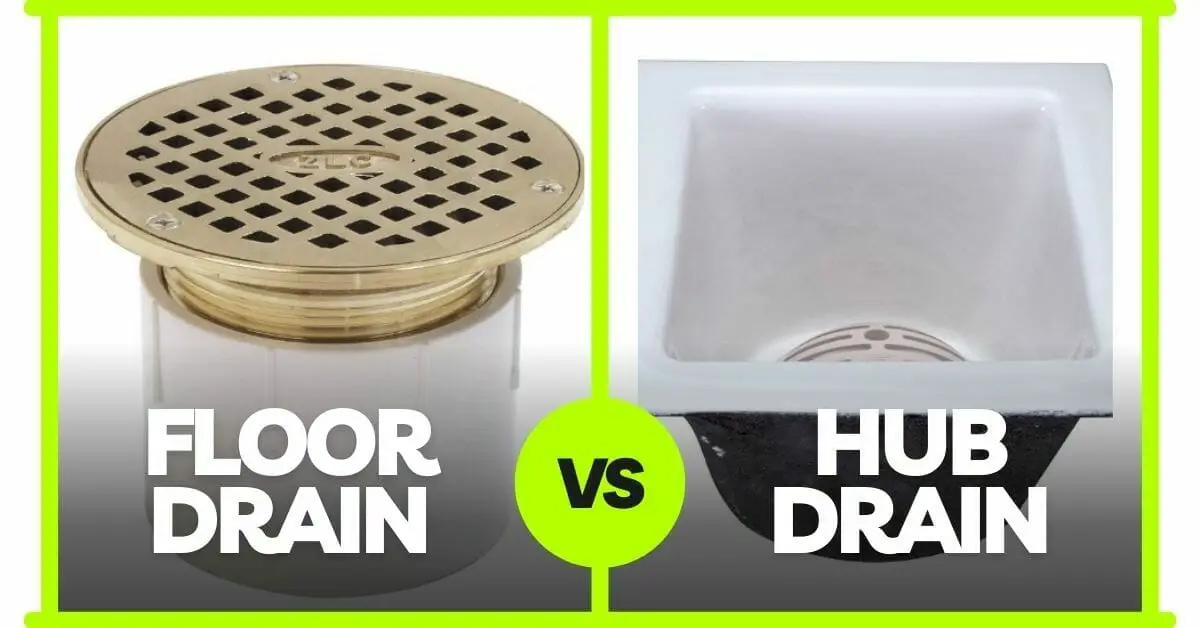When it comes to plumbing, there are many different types of drains to choose from. However, the two most common types are hub drains and floor drains. Both serve the purpose of draining water and waste from your home or business, but each has its own unique features and benefits. To help you better understand the difference between the two, we’ll explore what they are, how they work, and which one might be best for your needs.
Difference of Hub and Floor Drain
A hub drain primarily serves the purpose of indirectly removing liquid waste from fixtures, while a floor drain is designed to facilitate the direct drainage of water and other liquids into the drain.
Hub Drain: Indirect removal of liquid waste from fixtures.
Floor Drain: Direct removal of water and liquids from the floor.
What is a Hub Drain?

A hub drain is a type of plumbing drain that is primarily used for residential sewage systems. They feature a hub connection, which is a type of pipe fitting that allows multiple pipes to be joined together. Hub drains are typically found in basements, laundry rooms, and other areas of the home that require water and waste drainage. They can be installed below the floor level, or they can be installed above the floor level with a raised platform.
How Does a Hub Drain Work?
Hub drains work by allowing water and waste to flow into a holding tank or sump pit, which then pumps the waste up and out of the home through a pipe. The hub connection allows for a tight seal, which prevents any sewage from leaking out of the drain. This type of drain is typically installed when the sewage system is below the level of the main waste line.
What is a Floor Drain?

A floor drain, on the other hand, is a type of plumbing drain that is primarily used for commercial and industrial settings. They are designed to drain water and waste from large open spaces such as laundry rooms, locker rooms, and commercial kitchens. Floor drains are typically found at ground level, and are made from materials such as cast iron, steel, or plastic.
Hub Drain vs Floor Drain: Which One is Best for You?

The choice between a hub drain and a floor drain depends on various factors, including the specific application, location, and intended use. Let’s examine both options in detail to help you determine which one might be best for your needs:
- Hub Drain:
- Hub drains are typically used in plumbing systems, especially in commercial and industrial settings. They are designed to connect pipes and drain wastewater from sinks, showers, and other fixtures.
- Advantages of Hub Drains: a. Versatility: Hub drains can be connected to various fixtures and plumbing systems, making them adaptable to different situations. b. Easy Maintenance: They are relatively easy to maintain and repair since you can access them through the pipes. c. Longevity: Hub drains are often made from durable materials like cast iron, which can withstand heavy use and corrosion.
- Common Applications: Hub drains are commonly used in commercial kitchens, industrial facilities, and large-scale plumbing systems where multiple fixtures need drainage connections.
- Floor Drain:
- Floor drains, as the name suggests, are designed to be installed directly into the floor or ground. They are primarily used to collect and remove water and other liquids that might accumulate on the floor.
- Advantages of Floor Drains: a. Effective Water Removal: Floor drains are excellent at efficiently removing water, preventing pooling and potential damage to flooring materials. b. Safety: They help maintain a safe environment by preventing slip and fall hazards caused by standing water. c. Hygiene: Floor drains are often used in areas where cleanliness is essential, such as commercial kitchens and food processing facilities.
- Common Applications: Floor drains are commonly found in areas like bathrooms, basements, garages, and industrial settings where water spillage is frequent.
Choosing the Best Option: To determine which option is best for your specific situation, consider the following factors:
- Location: Where do you need the drainage system? If it’s in a sink or shower area, a hub drain might be more appropriate. If it’s on the floor to manage spills or wastewater, a floor drain is likely the better choice.
- Purpose: Consider the primary purpose of the drainage. If you want to remove wastewater from fixtures, a hub drain is suitable. If you need to manage surface water or prevent standing water in an area, a floor drain is the way to go.
- Maintenance: Think about ease of maintenance. Hub drains are typically easier to access for cleaning and repairs. Floor drains may require more regular cleaning due to debris accumulation.
- Material: Consider the materials and construction. Hub drains are often made of cast iron or durable plastics, while floor drains are available in a variety of materials, including stainless steel and PVC.
- Codes and Regulations: Be sure to comply with local building codes and regulations, as they may dictate the type of drain you must use in specific applications.
In conclusion, the choice between a hub drain and a floor drain depends on your specific needs, location, and intended use. Both types have their advantages, so it’s essential to evaluate these factors carefully to determine which one is best suited for your particular situation.
Ao Smith vs Bradford White Gas Water Heaters – Which One Best?
Comparison Table
| Feature | Hub Drain | Floor Drain |
|---|---|---|
| Placement | Typically installed in the center of a shower or wet room floor. | Installed at the edge or perimeter of a floor or shower area. |
| Drainage Area | Limited drainage area due to its central location. | Wider drainage area due to its peripheral placement. |
| Installation | Requires precise positioning during installation to ensure proper water flow. | Easier to install as it can be positioned at the lowest point of the floor. |
| Design Options | Limited design options, usually available in round or square shapes. | Wide range of design options, including different shapes, sizes, and finishes. |
| Water Flow Rate | Generally capable of handling moderate water flow. | Typically designed to handle higher water flow rates. |
| Accessibility | May be more difficult to access for maintenance or cleaning purposes. | Easier accessibility for maintenance or cleaning due to its peripheral placement. |
| Clogging Risk | Potentially higher risk of clogging as it is placed in the middle of the floor. | Lower risk of clogging due to its position at the edge of the floor. |
| Aesthetic Appeal | May create a focal point in the shower area, especially with decorative designs. | Generally blends with the surrounding floor, providing a seamless look. |
| Cost | Can vary depending on the material, design, and installation complexity. | Generally more affordable due to simpler installation requirements. |
| Common Usage | Commonly used in showers or wet rooms where central drainage is desired. | Suitable for various applications, including bathrooms, laundry rooms, basements, and outdoor areas. |
How Does a Floor Drain Work?
Floor drains work by allowing water and waste to flow onto a sloped surface, which then channels the waste into the drain. The drain is designed with a trap, which prevents any unwanted odors or gases from escaping into the room. This type of drain is typically installed in areas where water and waste need to be drained quickly, such as commercial kitchens or industrial facilities.
- Kitchen Sink Suddenly Stopped Working: Quick Fixes and Tips
- Hub Drain vs Floor Drain: What You Need to Know
- What to Do If Sink Drain Plug is Stuck: Quick Fixes
- How to Fix Leaky Kitchen Faucet Single Handle: Easy DIY Guide
- How to Unblock Kitchen Sink Without Plunger: Easy Tips
- How to Clean Kitchen Sink Drain Smell: Effective Tips
- Kitchen Sink Plumbing Problems: Top Solutions to Save Your Day
- Can a Handyman Install a Dishwasher? Expert Tips & Advice
- What is the Standard Kitchen Sink Size: Complete Guide
- Kitchen Plumbing Vs. Bathroom Plumbing: A Comprehensive Guide
- How to Install Double Kitchen Sink Plumbing: Step-by-Step Guide
- 3 Compartment Sink Air Gap Drain
- Garbage Disposal Runs Then Water Comes Back Up
- Kitchen Sink Plumbing Rough in Height
- P Trap Lower Than Drain Pipe: Step By Step Fix!
- Washer And Sink on Same Drain: How To?
- Washing Machine Box Rough in Height
- Peerless Faucet Reviews: The Ultimate Guide
- Moving Kitchen Sink To Another Wall – Step by Step Guideline
- Water Heater Gas Control Valve Smells Like Gas: Causes and Solutions

